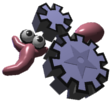Predator - prey ecosystem

Introduction
Natural ecologies can be studied as in terms of interactions between predators and their prey. The population sizes of both species can fluctuate as a consequence of births, consumption and mortality.
The goal of this project is to model predator-prey population dynamics. It can be extended with local reproduction to study the influence of space on population dynamics.
Model description
- Create two populations: food (prey) and food-seekers (predators).
- Give individuals of both populations a variable called 'energy'
- Collisions between a prey and a predator result in transferral of 'energy'
- Let prey reproduce periodically and logistically (i.e. probability of successful reproduction decreases as prey population size increases).
- Let predators reproduce when their energy >= some reproduction threshold.
- Prey and predators die when energy <= 0.0
Extension
Offspring can be placed either:
- in a random place
- close to its parent
In the first case, the populations are roughly uniformly distributed in the environment. This model approaches the behavior of traditional model of population dynamics (e.g. Lotka-Volterra system).
In the second case, the populations are clustered in space, which alters the population dynamics.
Comparison of these models shows the influence of space on population dynamics.

